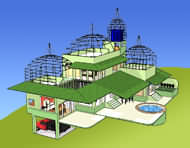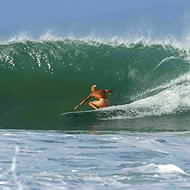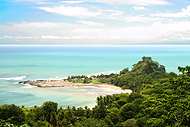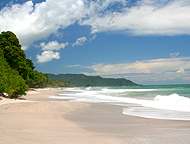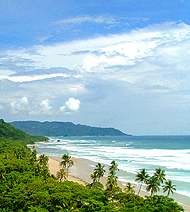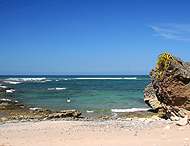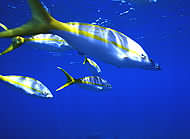By Geoff McCabe
If you’re thinking about developing a property in Costa Rica, and you’re reading this, then you’re already taking a good first step in seeking information about green building in the tropics. In developed countries such as the U.S., Canada, and Europe, the market is rapidly moving towards more ecological and sustainable building techniques, which result in a superior product.
In general, “green building” is a construction technique that involves using less waste, less toxic chemicals, less energy, and requires less ongoing maintenance, creating a healthier living environment for the owner. Green building has become the fastest-growing category of construction in the U.S., especially among luxury house designers. It makes sense… if you’re richer and can afford it, wouldn’t you rather have a house for your family that has less poisons in it and is better for the environment? Green building appeals to wealthier clients also because it is generally a little more expensive, so it is a status symbol. In the U.S. media, Hollywood celebrities now brag about their new eco-friendly “hybrid” cars, their solar panels on their houses, etc. It’s just like how the grocery store Whole Foods has become the store in which the rich people are shopping… it’s not just that it’s got the healthiest food, but it’s the most expensive, so “green” is becoming a luxury add-on in the market. And of course, product markets in general always follow what the rich are doing.
However, from a developer’s point of view, building green doesn’t have to mean that it always COSTS more. It’s possible for a developer to incorporate some green building techniques that won’t cost you more, but will allow you to charge more, therefore improving your profits while also creating a superior product that’s seen as upscale in the market. Some of these are:
-
— Using chemical-free stuccos, made in Costa Rica.
— Creating house designs that use natural air flow and breezes for cooling, rather than Air Conditioning
— Using architectural styles that provide lots of shade, keeping the sun off the sides of a house. This keeps the house cool, and creates more outside living area.
— Using recycled plastics as roofing materials, or replacing wood with recycled plastic beams
— Creating outside bathrooms with the shower in the open air, adding more usable space to the house for less $ per m2.
— Recycling or re-use of grey water to be used either for flushing toilets, or to water plants in the garden.
— Reforesting part of the property with rare and endangered native hardwood trees ($1 or less per tree) and planting fruit trees for your clients and for the animals. Also, planting lots of flowers that attract butterflies, which also attracts more birds.
— Design using as many locally produced materials and furniture as possible
Be especially careful about being perceived as “green-washing”, which is when developers simply attempts to brand their development as green simply by highlighting the fact that it has trees and animals on it, while claiming some type of ecological superiority. This is common in Costa Rica – when a developer has a property that has no ocean views and doesn’t want to spend money on bringing in power, water, and decent access roads to the lots, some attempt to obfuscate these facts by claming that they are an ecological community! Consumers are becoming ever more immune to these types of marketing strategies, and justifiably cynical about the companies that use them. The key is to offer a truly superior product that differentiates itself from your competitors. Especially in Costa Rica, people investing or moving here are weary of marketing ploys and want to experience the real deal.
The market is rapidly moving towards green building in the U.S. and Europe, so every developer in Costa Rica who is hoping to appeal to foreigners should pay attention and think ahead to attract this clientelle. Over the lifetime of your development, green building will become ever more important.
To see an example of an eco-house, click here: sustainable green building techniques.
